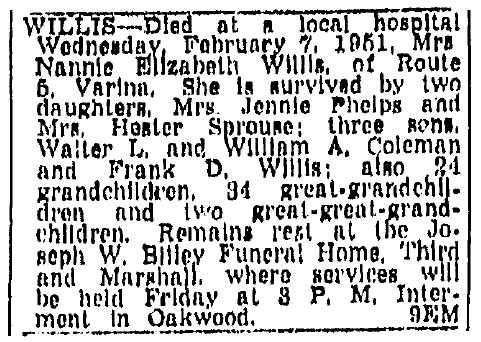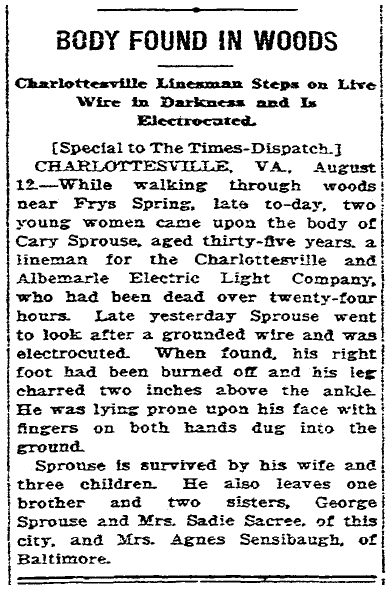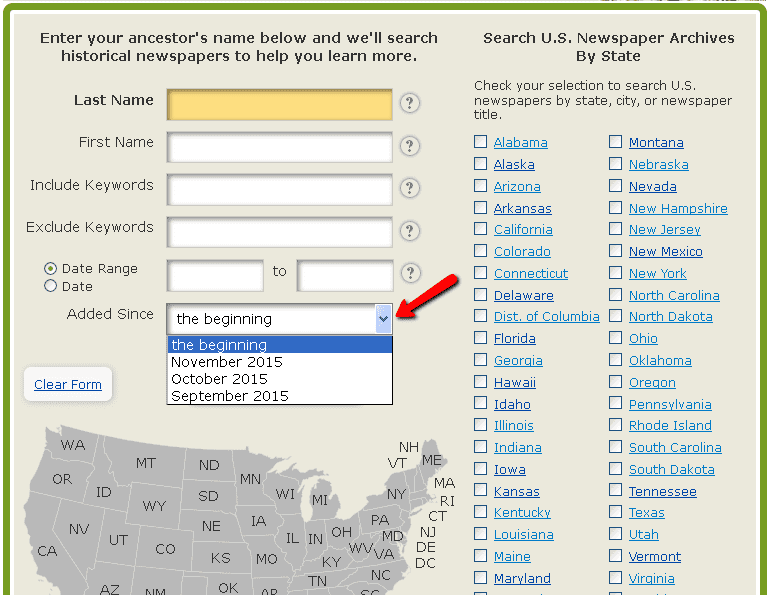Every genealogist has experienced it: hitting the dreaded “brick wall” – when you reach a dead end in your family history research, unable to find any more records to fill in the missing names, dates or places of your ancestor’s story.
On the other hand, few genealogy stories are more encouraging than hearing of someone smashing through their brick wall, finally getting the answers they spent years searching for with equal measures of determination and frustration.

It took Debby Abad 15 years, but she finally broke through her own brick wall. Here’s how she did it.
As Debby explains:
I have been searching for information on my great grandmother Nannie Willis, and my great uncle Cary Sprouse, for the last 15 years. Without a date, I could not apply for a death record.
Debby had been a member of GenealogyBank and found information about other members of her family, but after thoroughly searching its Historical Newspaper Archives could not find any articles about Nannie or Cary’s deaths – so she didn’t renew her membership.
Two years later, Debby learned that GenealogyBank is constantly adding new content every single day, adding millions more genealogy records and newspaper articles every month. Having been frustrated everywhere else she had looked, Debby decided to come back and give GenealogyBank one more try – and was glad she did!
As Debby wrote to us:
You can imagine my surprise when these articles popped up! I now had dates and could locate death records for my uncle and grandmother!!
Imagine her delight when she did a new search on her great grandmother Nannie Willis – and up popped the elusive record she had spent years looking for: her great grandmother’s obituary.

Finally she knew the date of Nannie’s death: 7 February 1951. Not only did this obituary give her this important information, it was filled – as obituaries often are – with many more family history clues: the names of Nannie’s three surviving sons and the married names of her two surviving daughters, plus the fact that Nannie had 24 grandchildren, 34 great-grandchildren and 2 great-great-grandchildren. Armed with this information, Debby now had many more directions in which to pursue her family history research.
Perhaps even more dramatic was what happened when Debby searched for her great uncle Cary Sprouse, trying once again to find out when – and how – he died. When this article popped up, Debby at long last had her answers.

There it was, the long-sought date of Cary’s death: 11 August 1917. And, like Nannie’s obituary, this article gives other family history clues: Cary was survived by his wife and three children, and his surviving brother and two sisters are named along with the cities where they lived. Now Debby had even more directions to pursue her family history research.
This article about her great uncle’s death makes an important point about using old newspapers for family history research: government records can give names and dates, but to learn something about our ancestors as people, and the individual lives they lived, we need their stories – and these stories are found in old newspapers.
Sometimes the stories we learn about our ancestors are not pretty, but they are real – and they’re our ancestors’ stories. In this case, Cary died a gruesome death by electrocution while trying to locate and fix a live wire that had fallen to the ground. The article gives some grisly details of Cary’s death, including the poignant detail of his having been found “lying prone upon his face with fingers on both hands dug into the ground” due to the agony of the electricity burning through his right foot and leg.
Not a comforting picture. But now, as Debby looks at Cary’s name and dates on her family tree, she at least knows the story of his death and can take comfort in the fact that he died doing his job, trying to restore power to his community.
Our congratulations to Debby for breaking through her genealogy brick wall, and our thanks for sharing her story with us and giving us permission to tell that story to our readers.
As we often remind readers here in the GenealogyBank Blog, it pays to redo your searches periodically in GenealogyBank. Just because you didn’t find something a week, month, or several months ago, doesn’t mean we don’t have something on your ancestors now. There is a feature on the newspapers’ search box that lets you search just on the content added since a certain time:
GenealogyBank adds millions of new records monthly, so keep searching. And good luck!
Have you had success breaking through a genealogy brick wall in your family history research? If so, please tell us about it in the comments section.
Note: FamilySearch International (FamilySearch.org) and GenealogyBank are partnering to make over a billion records from recent and historical obituaries searchable online. The tremendous undertaking will make a billion records from over 100 million U.S. newspaper obituaries readily searchable online. The newspapers are from all 50 states and cover the period 1730 to the present. Find out more at: https://www.genealogybank.com/family-search/
Explore over 330 years of newspapers and historical records in GenealogyBank. Discover your family story! Start a 7-Day Free Trial
Related Brick Wall Articles:

